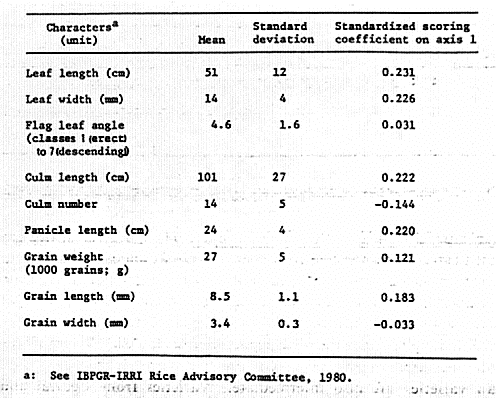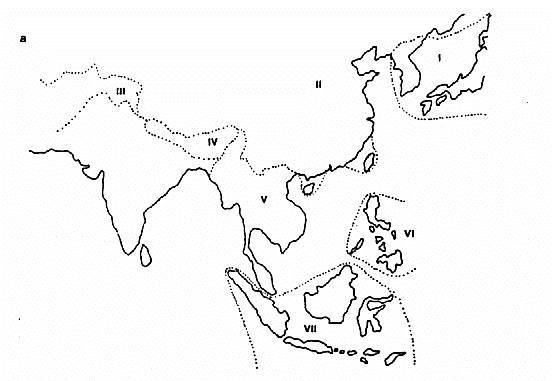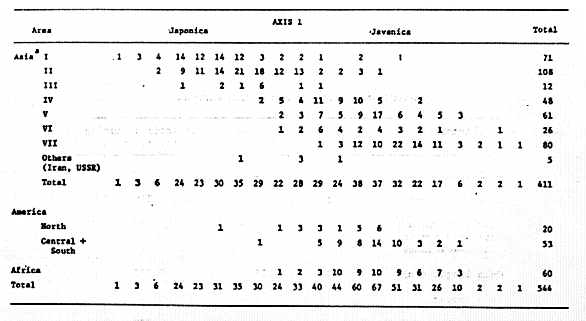IRRI, P.O. Box 933, Manila, Philippines; IRAT/CIRAD, 45 bis avenue de la Belle Gabrielle, 94736 Nogent Sur Marne Cedex, France
Rice varieties are often classified as so-called Indica, Japonica and Javanica
groups on the basis of morphological variations. The F\1\ hybrids between
varieties belonging to the latter two types, however, have normal F\1\
fertility (Morinaga 1958). When some morphological and physiological characters
(Oka 1958; Cheng 1985) as well as isozymes (Glaszmann et al. 1984) are
considered these two groups can be lumped together. We studied plant type
variation in a large sample of this major group to test the relevance of the
Japonica-Javanica distinction.
Five hundred forty four accessions from the International Rice Germplasm Center (IRGC) representing main areas of this major group were sampled.
The data from the IRGC for nine morphological characters were subjected to a principal component analysis. One main axis of differentiation appeared, which accounted for 41% of the whole variance. The characters which contribute most to it (Table 1. Variation for 9 morphological characters and constitution of axis 1 of its principal component analysis) are the ones which are used in Japonica-Javanica distinction. Varieties are grouped into main geographic areas to analyze their distribution along the axis (Fig. 1 Asian geographic areas as considered in Table 2, Table 2 Distribution of 544 varieties along the first axis of a principal component analysis of the variation for 9 morphological characters). Variation is continous between two extremes. These extremes are constituted by Japanese and Korean varieties with lower scores, and Indonesian varieties with higher scores. In Asia, Intermediates found in mountainous areas of Southeast Asia and along the Himalayas. Most North American varieties are also intermediate. Varieties from Central and South America and from Africa have higher scores.
According to these results, plant type displays a geographical cline between two extremes, which are temperate and tropical forms of a unique group. Such information, with that cited above, clearly shows that the so-called Javanica varieties are the tropical forms of a single Japonica senus largo group in which morphological variation is related to geography. Thus the use of the "Javanica" term at the same rank as "Indica" and "Japonica" is incorrect.
Table 1. Variation for 9 morphological characters and constitution of axis 1 of
its principal component analysis

Fig. 1. Asian geographic areas as considered in Table 2.

Table 2. Distribution of 544 varieties along the first axis of a principal
component analysis of the variation for 9 morphological characters

References
Cheng, K.S. 1985. A statistical evaluation of the classification of rice cultivars into hsien and keng subspecies. RGN 2: 46-48.
Glaszmann, J.C., H. Benoit and M. Arnaud, 1984. Classification des riz cultives (Oryza sativa L.). Utilisation de la variabilite isoenzymatique. Agro. Trop. 39(1):51-66.
IBPGR-IRRI Rice Advisory Committee, 1980. "Descriptors for Rice" (Oryza sativa L.). IRRI, Los Banos, Philippines.
Morinaga, T., 1968. Origin and geographical distribution of Japanese rice. JARQ 3:1-15.
Oka, H.I., 1958. Intervarietal variation and classification of cultivated rice. Indian J. Genet. Plant Breed. 18: 79-89.